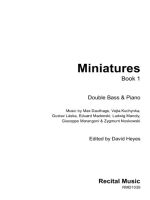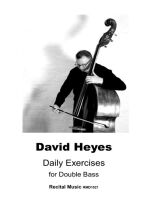Toccata & Fugue

Product code:
£8.50
Description
Bach’s Toccata & Fugue in D minor is a cornerstone of the organ repertoire and is one of the most recognisable works to classical music lovers around the world. It is uncertain when it was written and was first published in 1833, based on a manuscript copy made by the German composer and organist Johannes Ringk.
The magnificent arrangement for unaccompanied double bass by Miloslav Gajdoš offers musical and technical challenges throughout and is a monumental and outstanding to the transcription repertoire. It sounds in C minor when played in orchestral tuning and in D minor, its original key, when played in solo tuning.
“From the time I seriously started studying the double bass, I realised there was no solo piece for instrument by J. S. Bach. The double bass orchestral parts in his 3rd Brandenburg Concerto or in the Violin Concerto in E major and Double Concerto in D minor for two violins are not enough, even though they are beautiful.
Sometime in 1966, whilst studying at the conservatoire, I was enthralled by hearing the Menuets from the third Cello Suite and together with the Sarabande and Gigue, I decided to rework them for double bass. I chose to use tenor clef instead of bass to achieve the sound, which would not to be too high nor too low. This proved to work even in other cello suites which I later used as study material for my students.
At the beginning of 1990’s I concentrated on three violin partitas and strangely they are more suitable for double bass than the cello suites. I also used tenor clef, instead of treble clef, because the key of the solo double bass remains the same as violin. It was a monumental task to work on the Chaconne, which was also perfect for playing on double bass. This piece only needed a few minimal changes and I performed it in Berlin 1988 with great success.
Frederick Charlton posted a video performing Bach’s Toccata and Fugue in 2010 in which he preserved the original D minor key for orchestra tuning. After seeing this video, I decided to rewrite this piece for unaccompanied double bass, where the originally dominant note of A would be played on the highest open string.
The premiere of my transcription was in Brno (Czech Republic) in 2011, with very positive feedback. Because the Toccata & Fugue is originally written for organ, it gives the double bass the opportunity to use and show beautiful tone in middle, higher and lower pedal positions. Thanks to very interesting melodic and harmonic sequences we can say the double bass interpretation has been enriched by, so far unknown, resources which build extraordinary place for new repertoire.”
[Programme note by Miloslav Gajdoš / Kroměříž 15 January 2023]
Description
Bach’s Toccata & Fugue in D minor is a cornerstone of the organ repertoire and is one of the most recognisable works to classical music lovers around the world. It is uncertain when it was written and was first published in 1833, based on a manuscript copy made by the German composer and organist Johannes Ringk.
The magnificent arrangement for unaccompanied double bass by Miloslav Gajdoš offers musical and technical challenges throughout and is a monumental and outstanding to the transcription repertoire. It sounds in C minor when played in orchestral tuning and in D minor, its original key, when played in solo tuning.
“From the time I seriously started studying the double bass, I realised there was no solo piece for instrument by J. S. Bach. The double bass orchestral parts in his 3rd Brandenburg Concerto or in the Violin Concerto in E major and Double Concerto in D minor for two violins are not enough, even though they are beautiful.
Sometime in 1966, whilst studying at the conservatoire, I was enthralled by hearing the Menuets from the third Cello Suite and together with the Sarabande and Gigue, I decided to rework them for double bass. I chose to use tenor clef instead of bass to achieve the sound, which would not to be too high nor too low. This proved to work even in other cello suites which I later used as study material for my students.
At the beginning of 1990’s I concentrated on three violin partitas and strangely they are more suitable for double bass than the cello suites. I also used tenor clef, instead of treble clef, because the key of the solo double bass remains the same as violin. It was a monumental task to work on the Chaconne, which was also perfect for playing on double bass. This piece only needed a few minimal changes and I performed it in Berlin 1988 with great success.
Frederick Charlton posted a video performing Bach’s Toccata and Fugue in 2010 in which he preserved the original D minor key for orchestra tuning. After seeing this video, I decided to rewrite this piece for unaccompanied double bass, where the originally dominant note of A would be played on the highest open string.
The premiere of my transcription was in Brno (Czech Republic) in 2011, with very positive feedback. Because the Toccata & Fugue is originally written for organ, it gives the double bass the opportunity to use and show beautiful tone in middle, higher and lower pedal positions. Thanks to very interesting melodic and harmonic sequences we can say the double bass interpretation has been enriched by, so far unknown, resources which build extraordinary place for new repertoire.”
[Programme note by Miloslav Gajdoš / Kroměříž 15 January 2023]



